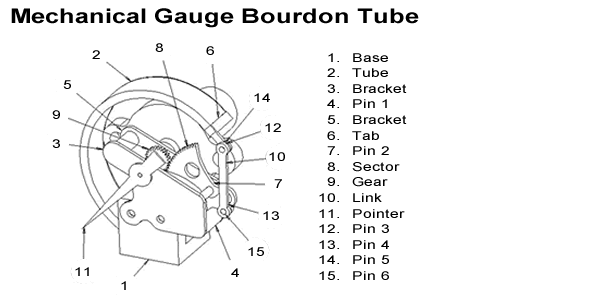|
|
|
|
|
|
Comp II LED
Comp II
SCX Black
SCX Silver
SCX White
60s Muscle
MINI Factory Match
Liquid Filled
Non-Filled Direct Mount
Engine Thermometers
Accessories
All Gauges
1" Dial (K)
1½" Dial (A)
2¼" Dial (B)
3" Dial (E)
3" Asphalt (E)
3" Bottom Mount (J)
3" Asphalt (J)
3" Adjustable (ADJ3)
5" Dial (G)
5" Adjustable (ADJ5)
5" Bottom Mount (GJ)
Engine Thermometers
Capillary
Industrial
All Thermometers
Utility, Lower Mount
SS/Brass, Lower Mount
SS/Brass, Center Back
SS/Brass, U-Clamp
SS/Brass, Panel Mount
All SS, Lower Mount
All SS, Panel Mount
4" All SS
4.5" Process Gauges
2" All SS (Q3)
2½" All SS (K)
2½" SS/Brass (J)
4" All SS (G)
4½" Process (MPB/SC)
6" All SS (H)
All McDaniel Gauges
General Service
Severe Service 63mm
Severe Service 100mm
Diaphragm Gauges
Process Gauges
All MARSH Gauges
MARSH PDF Catalog
|
|
How Does a Mechanical Gauge Work? Mechanical gauges utilize an internal bourdon tube. One end of the bourdon tube is connected to a gear and shaft assembly that moves a pointer. When the pressure inside the bourdon tube increases, the bourdon tube uncoils slightly. The amount of uncoiling that occurs is proportional to the pressure inside the bourdon tube. As the tube uncoils, its motion activates the gear and shaft system that turns the pointer on the gauge. While all that you see when you look at the gauge is the pointer moving, you should understand that there is a small, bent tube (the bourdon tube) that's coiling and uncoiling with each change in the pressure inside that tube.
Mechanical pressure gauges are connected directly to the process fluid being measured (i.e. oil). As the process fluid pressure changes the pressure on the bourdon tube also changes which in turn moves the pointer on the gauge. Mechanical temperature gauges also utilize a bourdon tube. They have a sealed capillary tube and bulb assembly that is filled with temperature sensitive liquid that produces a proportional vapor pressure on the bourdon tube. As the temperature changes, the pressure inside the bourdon tube changes, which in turn moves the pointer on the gauge. Back to FAQs
|
|
|
|
|||||
| Auto Gauges | Thermometers | McDaniel | Marsh | ||
